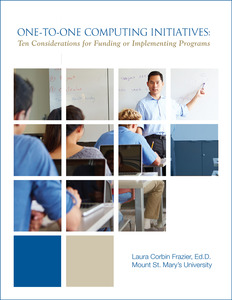One-to-One Computing Initiatives
By Laura Corbin Frazier, Ed.D.
04-08-2014
Ten considerations for funding or implementing programs
 I first met Knott Foundation Executive Director, Kelly Medinger, in a small Catholic school that was expanding its technology resources. The Knott Foundation and Mount St. Mary’s University were partners with the school in this growth; the Knott Foundation with much needed funding and the university with professional development collaboration. However, on that day and in subsequent discussions, our focus was not on specific technology tools, but instead on instructional decision-making using technology.
I first met Knott Foundation Executive Director, Kelly Medinger, in a small Catholic school that was expanding its technology resources. The Knott Foundation and Mount St. Mary’s University were partners with the school in this growth; the Knott Foundation with much needed funding and the university with professional development collaboration. However, on that day and in subsequent discussions, our focus was not on specific technology tools, but instead on instructional decision-making using technology.
The Knott Foundation makes numerous decisions regarding grant applications each year, many of which include requests for specific technology infrastructure. But there are also a growing number of requests for one-to-one computing initiatives (one mobile device for each student). These requests parallel current demands for increased student readiness with 21st Century skills and a growing number of success stories from states, districts, and classrooms using mobile devices to enhance student learning.
My research agenda includes technology integration in schools, which necessarily encompasses one-to-one computing. The Knott Foundation, seeking research on the effectiveness of one-to-one computing initiatives to both inform their own work and support others in education, provided me the opportunity to review research on one-to-one computing initiatives and to engage in a research study on teacher technology decision-making in a one-to-one iPad initiative.
The linked article is the product of the first phase of that research and summarizes my findings from review of nearly 100 research studies and reports. The article highlights ten key considerations for technology decision-makers, with a specific focus on those new to one-to-one computing initiatives. In my discussion of each consideration area, I have highlighted current research findings that influenced my recommendation. Additionally, I have provided a list of online resources with how-to guides, success stories, and strategies to further support those beginning a one-to-one initiative.
The article is not designed to be a step-by-step guide to starting one-to-one computing initiatives, though the issues presented do generally coincide with the development process. Rather, it is intended to be a part of the discussion on issues confronting those seeking innovative change using one-to-one computing. In considering such initiatives numerous questions are raised such as:
- What are the impacts and gains for an institution?
- Is student achievement likely to improve?
- What are new requirements of students and teachers?
- Are there advantages/disadvantages to using different technologies?
- Do the benefits support the costs?
The article aims to synthesize research on these and many other common questions associated with one-to-one computing into the ten most prominent considerations for decision-makers. I hope you find the article both informative and useful.
Laura Corbin Frazier, Ed.D., is an Assistant Professor of Education in the School of Education and Human Services at Mount St. Mary’s University in Emmitsburg, Maryland. Dr. Frazier specializes in instructional technology and distance education. Her research interests couple these areas with new teacher preparation and professional development schools.
